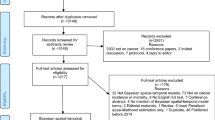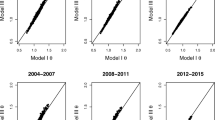Abstract
Lung cancer is the second most commonly diagnosed cancer in both men and women in Georgia, USA. However, the spatio-temporal patterns of lung cancer risk in Georgia have not been fully studied. Hierarchical Bayesian models are used here to explore the spatio-temporal patterns of lung cancer incidence risk by race and gender in Georgia for the period of 2000–2007. With the census tract level as the spatial scale and the 2-year period aggregation as the temporal scale, we compare a total of seven Bayesian spatio-temporal models including two under a separate modeling framework and five under a joint modeling framework. One joint model outperforms others based on the deviance information criterion. Results show that the northwest region of Georgia has consistently high lung cancer incidence risk for all population groups during the study period. In addition, there are inverse relationships between the socioeconomic status and the lung cancer incidence risk among all Georgian population groups, and the relationships in males are stronger than those in females. By mapping more reliable variations in lung cancer incidence risk at a relatively fine spatio-temporal scale for different Georgian population groups, our study aims to better support healthcare performance assessment, etiological hypothesis generation, and health policy making.









Similar content being viewed by others
Abbreviations
- CAR:
-
Conditional autoregression
- CI:
-
Credible interval
- DIC:
-
Deviance information criterion
- GIS:
-
Geographical information system
- MCMC:
-
Markov chain Monte Carlo
- RR:
-
Relative risk
- SES:
-
Socioeconomic status
- SIR:
-
Standardized Incidence Ratio
References
Abellan JJ, Richardson S, Best N (2008) Use of space-time models to investigate the stability of patterns of disease. Environ Health Perspect 116(8):1111
ACS (2013) American Community Survey data on geographical mobility/migration. http://www.census.gov/hhes/migration/data/acs.html. Accessed 10 Oct 2013
Bernardinelli L, Clayton D, Pascutto C, Montomoli C, Ghislandi M, Songini M (1995) Bayesian analysis of space-time variation in disease risk. Stat Med 14(21–22):2433–2443
Besag J, York J, Mollié A (1991) Bayesian image restoration, with two applications in spatial statistics. Ann Inst Stat Math 43(1):1–20
Best N, Wakefield J (1999) Accounting for inaccuracies in population counts and case registration in cancer mapping studies. J R Stat Soc Ser A (Stat Soc) 162(3):363–382
Best N, Richardson S, Thomson A (2005) A comparison of Bayesian spatial models for disease mapping. Stat Methods Med Res 14(1):35
Brooks SP, Gelman A (1998) Alternative methods for monitoring convergence of iterative simulations. J Comput Gr Stat 7:434–455
Carstairs V (2001) Socio-economic factors at areal level and their relationship with health. Spatial. Epidemiology 1(9):51–68
CDC (2013) Behavioral risk factor surveillance system. http://www.cdc.gov/brfss/index.htm. Accessed 10 Oct 2013
Darden J, Rahbar M, Jezierski L, Li M, Velie E (2009) The measurement of neighborhood socioeconomic characteristics and black and white residential segregation in metropolitan Detroit: implications for the study of social disparities in health. Ann Assoc Am Geogr 100(1):137–158
Downing A, Forman D, Gilthorpe M, Edwards K, Manda S (2008) Joint disease mapping using six cancers in the Yorkshire region of England. Int J Health Geogr 7(1):41
Fortunato L, Abellan JJ, Beale L, LeFevre S, Richardson S (2011) Spatio-temporal patterns of bladder cancer incidence in Utah (1973–2004) and their association with the presence of toxic release inventory sites. Int J Health Geogr 10(1):16
Georgia Department of Public Health (2008) Cancer program and data summary (trans: Health GDoP). Atlanta, GA
Georgia Department of Public Health (2011) Georgia comprehensive cancer registry. http://www.health.state.ga.us/programs/gccr/. Accessed 4th Oct 2011
Goodchild MF, Lam NS (1980) Areal interpolation: a variant of the traditional spatial problem. Geo-Processing 1:297–312
Held L, Natário I, Fenton SE, Rue H, Becker N (2005) Towards joint disease mapping. Stat Methods Med Res 14(1):61–82
Kelsall J, Wakefield J (1999) Discussion of ‘ Bayesian models for spatially correlated disease and exposure data’, by Best et al. In: Bernardo J, Berger J, Dawid A, Smith A (eds) Bayesian statistics 6. Oxford University Press, Oxford, p 151
Knorr-Held L (2000) Bayesian modelling of inseparable space-time variation in disease risk. Stat Med 19(17–18):2555–2567
Knorr-Held L, Best NG (2001) A shared component model for detecting joint and selective clustering of two diseases. J R Stat Soc Ser A (Stat Soc) 164(1):73–85. doi:10.1111/1467-985x.00187
Krieger N (1992) Overcoming the absence of socioeconomic data in medical records: validation and application of a census-based methodology. Am J Public Health 82(5):703
Krieger N, Williams DR, Moss NE (1997) Measuring social class in US public health research: concepts, methodologies, and guidelines. Annu Rev Public Health 18(1):341–378
Krieger N, Chen JT, Waterman PD, Soobader MJ, Subramanian S, Carson R (2002) Geocoding and monitoring of US socioeconomic inequalities in mortality and cancer incidence: does the choice of area-based measure and geographic level matter? Am J Epidemiol 156(5):471
Lawson AB (2009) Bayesian disease mapping: hierarchical modeling in spatial epidemiology, vol 20. CRC, Boca Raton, FL
Lunn DJ, Thomas A, Best N, Spiegelhalter D (2000) WinBUGS-a Bayesian modelling framework: concepts, structure, and extensibility. Stat Comput 10(4):325–337
Mao Y, Hu J, Ugnat A-M, Semenciw R, Fincham S (2001) Socioeconomic status and lung cancer risk in Canada. Int J Epidemiol 30(4):809–817
Matukala Nkosi T, Parent M-É, Siemiatycki J, Rousseau M-C (2012) Socioeconomic position and lung cancer risk: how important is the modeling of smoking? Epidemiology 23(3):377
Menvielle G, Boshuizen H, Kunst AE, Dalton SO, Vineis P, Bergmann MM, Hermann S, Ferrari P, Raaschou-Nielsen O, Tjønneland A (2009) The role of smoking and diet in explaining educational inequalities in lung cancer incidence. J Natl Cancer Inst 101(5):321–330
Mollié A (2001) Bayesian mapping of Hodgkins disease in France. Spat Epidemiol 1(9):267–286
Openshaw S, Taylor PJ (1981) The modifiable areal unit problem. In: Wrigley N, Bennett R (eds) Quantitative geography: a British view. Routledge, London, pp 60–69
Population Estimates Program (2011) County intercensal estimates (2000–2010). http://www.census.gov/popest/data/intercensal/county/county2010.html. Accessed 22nd Feb 2012
Richardson S, Thomson A, Best N, Elliott P (2004) Interpreting posterior relative risk estimates in disease-mapping studies. Environ Health Perspect 112(9):1016
Richardson S, Abellan J, Best N (2006) Bayesian spatio-temporal analysis of joint patterns of male and female lung cancer risks in Yorkshire (UK). Stat Methods Med Res 15(4):385
Spiegelhalter DJ, Best NG, Carlin BP, Van Der Linde A (2002) Bayesian measures of model complexity and fit. J R Stat Soc Ser B (Stat Methodol) 64(4):583–639
Tassone EC, Waller LA, Casper ML (2009) Small-area racial disparity in stroke mortality: an application of Bayesian spatial hierarchical modeling. Epidemiology 20(2):234–241
van Loon AJM, Burg J, Goldbohm RA, van den Brandt PA (1995) Differences in cancer incidence and mortality among socio-economic groups. Scand J Public Health 23(2):110–120
Vena JE (1983) Lung cancer incidence among nonwhites in Erie County, New York. J Natl Med Assoc 75(12):1229
Wakefield J, Best N, Waller L (2001) Bayesian approaches to disease mapping. Spat Epidemiol 1(9):104–128
Waller L, Carlin B, Xia H, Gelfand A (1997) Hierarchical spatio-temporal mapping of disease rates. J Am Stat Assoc 92(438):607–617
Wheeler DC, Waller LA, Elliott JO (2008) Modeling epilepsy disparities among ethnic groups in Philadelphia, PA. Stat Med 27(20):4069–4085
Wheeler DC, Ward MH, Waller LA (2012) Spatial-temporal analysis of cancer risk in epidemiologic studies with residential histories. Ann Assoc Am Geogr 102(5):1049–1057
Xia H, Carlin B (1998) Spatio-temporal models with errors in covariates: mapping Ohio lung cancer mortality. Stat Med 17(18):2025–2043
Acknowledgments
All of the authors want to thank Dr. Sara Wagner for her help on the Georgia cancer data acquisition. Dr. John E. Vena's effort was sponsored in part by a Distinguished Cancer Scientist award from the Georgia Cancer Coalition (GCC).
Author information
Authors and Affiliations
Corresponding author
Electronic supplementary material
Below is the link to the electronic supplementary material.
Rights and permissions
About this article
Cite this article
Yin, P., Mu, L., Madden, M. et al. Hierarchical Bayesian modeling of spatio-temporal patterns of lung cancer incidence risk in Georgia, USA: 2000–2007. J Geogr Syst 16, 387–407 (2014). https://doi.org/10.1007/s10109-014-0200-4
Received:
Accepted:
Published:
Issue Date:
DOI: https://doi.org/10.1007/s10109-014-0200-4




